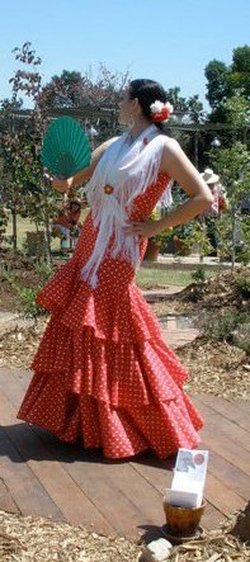
Oh, the Guajira. This rhythm has been haunting me for a few years. Mostly figuratively, but even literally. The other day while trying to choreograph a Guajira, I would pause the CD to take a break, and it would start playing by itself. I then stopped the CD entirely, and when I walked away, I once again started to hear those opening guitar chords, playing on their own. It was as if the pesky palo* was saying, "You're finally working with me and now you want to stop? No way. You're mine now".
I actually had a relationship with the Guajira long ago. It was the first full "solo" number I ever learned. I put it in quotes because I performed this number with about 40 other classmates in my Intro to Flamenco class at UCLA. It was exciting at the time. I got to have fun working with the fan, a traditional element of the Guajira, and I relished the fact that the lyrics were about some dude's desire to marry a beautiful Cuban girl from the countryside, a "guajira" (the rhythm itself is named after a Cuban rhythm by the same name). Being a Cuban girl, it was fun to pretend the verses were about me.
As a member of different dance companies, I have performed some version of the Guajira several times, with both a fan and a shawl. In Spain I had a teacher who dared to teach us a Guajira without the fan! "Why does the Guajira have to have a fan?," she asked, when a student questioned her methods. I liked her sense of rebellion, but I do prefer the fan for the Guajira. It's what gives it a bit of Cuban flare. It's the same reason I don't like Guajira lyrics that don't have to do with Cuba. I feel like, "what's the point in that?" To me what makes the Guajira special is its "Cubanness". Without that, I'd rather be dancing something else.
You see, over the years as I got more serious about Flamenco, I decided to focus on what are considered the more serious palos and I forgot about the poor Guajira. I started to see the Guajira as a gimmicky dance, used to give audiences the treat of some pretty props that we twirl around, but not something I considered to have any real substance. It's not just because it's a happy dance either. The Alegría de Cadiz is actually named after "happiness", but it is a robust dance, with lots of mood and rhythmic shifts built into it. There's a structure with a lot of meat to it. To me the Guajira just doesn't necessarily have that same depth. It's pretty with pretty lyrics and a sense of romance and flirtation. That's nice, but can you give a girl some angst?
These are just my excuses though. The reason I haven't done a Guajira solo in years is that people expect me to do so: "But you're Cuban! You of all people should have a Guajira". And that is why I don't. I know, it seems petty. Yes, partly it is. I have a rebellious streak and don't like to be told what to do. However, there's also a fearful perfectionism playing its hand here. I feel like if I'm Cuban, my Guajira better be the most Cuban Guajira ever and I want it to feel that way, right out the gate.
Here is where we learn the lesson about perfectionism--it gets you stuck. You don't let yourself create anything when you get hung up on wanting it perfect. It will never be perfect. I've been dancing Solea por Bulería for years now and people tell me they love my solo, but I know it's never perfect. I will always want it to be more. However, I also know that it is way better than it was when I first started putting it together back in Spain seven years ago. In fact, it barely looks the same. We have developed and melded together, fermenting like a fine wine.
So this is what I need to remind myself as I rekindle my love affair with my forgotten Guajira. We may start off with a bumpy beginning, but eventually we should smooth out and glide together. Or saunter. The word "saunter" keeps entering my head when I think about walking across the floor, slowly waving my fan, proudly embodying my ancestors onstage.
For now, I'll leave you with a sample. This is a video of Belén Maya dancing to Mayte Martín's cante. The choreography has some modern elements that you don't often see in a traditional Guajira, but I love this video because Belén captures the coquettish and sauntering feel that I think this palo should have. Also, I absolutely love the way Mayte sings Guajira. They are beautifully accompanied by Juan Ramón Caro on guitar. Enjoy!
* a particular rhythm or musical form in Flamenco
Did you like this post? Feel free to Like it and Share it and stay tuned for Part 2 where I will go over a bit of the history of the Guajira with more video samples.
What do you think of the Guajira? Are there other Flamenco palos you prefer? Do you also struggle with perfectionism? Feel free to share your thoughts below.
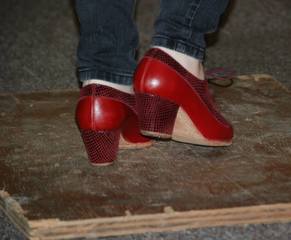
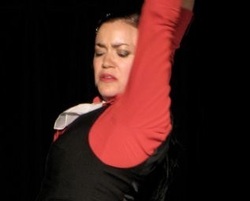

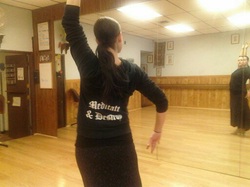
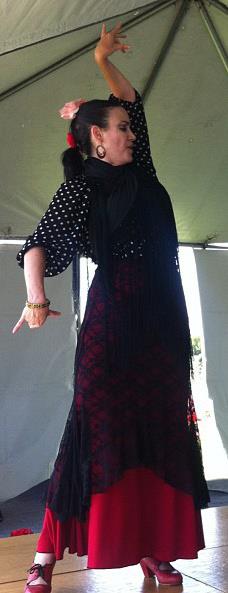
 RSS Feed
RSS Feed
